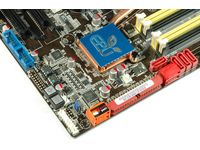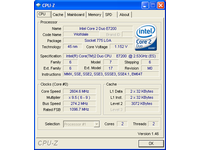Power-Saving Motherboards: Fact Or Fiction?
Asus P5Q Deluxe: EPU Power-Saving
BIOS Version: 1306
Asus offers a plethora of P45-based motherboards. For this review we opt for the high-end P5Q Deluxe. The manufacturer says this board is the “best computing and power-saving combined platform.” It comes with a slew of features, including the Asus EPU-6 power-saver and a massive 16-phase voltage regulator, as well as many other components designed to please the enthusiast.
Features & Interfaces
With three PCI Express slots, the P5Q Deluxe offers great connectivity for graphics. If only the blue, primary slot is used, graphics will run x16 PCIe 2.0. If two AMD cards are used in slots 1 and 2 (CrossFireX is supported), both cards will operate on x8 connections. The third x16 slot offers four PCIe 2.0 lanes. Two x1 slots are available for add-on cards, and there are two 32-bit PCI slots as well.
Dual DDR2 memory channels support memory speeds up to DDR2-1200. A Marvell storage controller provides an Ultra ATA/133 channel, which isn’t supported by the P45 chipset’s ICH10-R. A Silicon Image storage controller provides a pair of additional SATA ports, which can also be used for the Drive Xpert feature, to mirror data onto a couple of backup drives.
Finally, the Express Gate SSD feature provides a compact Linux operating system, which boots in a few seconds and provides access to the Internet and popular messaging networks. Two Marvell chips provide Gigabit Ethernet connectivity with teaming features to increase bandwidth or redundancy. High-definition audio is a given nowadays; the Asus P5Q Deluxe provides additional noise filtering and coaxial connectivity, as well as an optical S/PDFIF output at the back panel.
Efficiency Features
Get Tom's Hardware's best news and in-depth reviews, straight to your inbox.
Asus has come a long way toward optimizing power, although its active power-saving features are aren’t quite there yet. The Stack Cool 2 feature distributes heat onto an additional PCB layer on the back of the motherboard. AI Nap lets you put the system into a power-saving standby mode when you’re away from your PC.
However, the 16-phase VRM 11.1 voltage regulator, together with the EPU-6, forms the core of Asus’ power-saving efforts. The EPU controls phase-switching for voltage regulators used with key components, including the processor, chipset and memory, according to Asus; it adjusts the voltage-regulator configuration according to load.
EPU-6 Testing
The EPU-6 Engine offers five settings: Auto, Turbo, High Performance, Medium Power Saving, and Maximum Power Saving. The Auto and Power Saving profiles reduce CPU clock speed to 1,584 MHz at idle. Maximum Power Saving maintains that clock speed at all times, Auto goes back up to full speed if necessary and Medium Power Saving stays a few MHz below full clock speed. Turbo mode overclocks the system a bit.
Our first results with the EPU-6 were not impressive. After installing the EPU-6 Engine software, we set the system to Auto mode—which resulted in a full system crash. That’s one way to reduce power consumption. We restarted the system and could not reproduce the problem. Ultimately, though, system idle power dropped by 10 W.




Current page: Asus P5Q Deluxe: EPU Power-Saving
Prev Page ASRock P45R2000-WiFi: No Special Power-Saving Feature Next Page Asus P5Q-E: EPU Power-Saving
